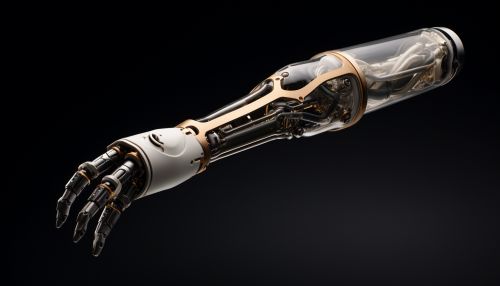Prosthesis
Overview
A prosthesis is a device designed to replace a missing part of the body or to make a part of the body work better. Diseased or missing eyes, arms, hands, legs, or joints are commonly replaced by prosthetic devices. These devices can be worn on the outside of the body and are easy to remove, or they can be surgically implanted inside the body.
History
The history of prosthetics and amputation surgery begins at the very dawning of human medical thought. The ancient Egyptians were the early pioneers in the field of prosthetics, as shown by the discovery of the oldest known splint from the fifth Egyptian Dynasty (2750–2625 BC). The early prosthetics of the Egyptians were simple devices, but they provided the basis for further development in the field.
Types of Prostheses
Prostheses are typically used to replace parts of the body that have been lost due to injury or disease. The type of prosthesis depends on what part of the body is affected.
Upper-limb Prostheses
Upper-limb prostheses are devices designed to replace, as much as possible, the function or appearance of a missing upper limb. These prostheses can be categorized into two main groups: transradial (below the elbow) and transhumeral (above the elbow).
Lower-limb Prostheses
Lower-limb prostheses provide replacements at varying levels of amputation: foot, below-knee (transtibial), above-knee (transfemoral), and hip disarticulation. These prostheses must be a unique combination of appropriate materials, alignment, design, and construction.
Craniofacial Prostheses
Craniofacial prostheses, also known as epistheses, are prosthetics for the face and head, and are typically used to replace areas damaged by disease or trauma. They are usually attached to the affected area of the face using osseointegrated (bone-anchored) implants and magnets.
Materials and Design
Prosthetic devices have evolved significantly since the days of wooden legs and iron hands. Modern prosthetics are made from a variety of materials, including plastics, metals, and composites, and are designed to be lightweight, strong, and functional.
Prosthetic Control
Controlling a prosthesis is a complex task. The most common control system for an upper-limb prosthesis is body-powered, using cables and the movement of other body parts to control the prosthesis. More advanced control systems use electrical signals from the body to control the prosthesis.
Future of Prosthetics
The future of prosthetics is a rapidly advancing field, with improvements in technology and materials that promise to make prosthetic devices more comfortable, more lifelike, and more functional than ever before.


